Papers by Claire Malleson
Antiquity, 2024
Excavations at the site of Tell el-Retaba since 2007 have revealed an extensive settlement and as... more Excavations at the site of Tell el-Retaba since 2007 have revealed an extensive settlement and associated material culture dating from the Third Intermediate Period (1070-664 BC). This work represents the only largescale investigation into domestic archaeology from this period in Egypt and the results offer important insights into aspects of urban life for an under-studied phase of Egyptian history.
Polish Archaeology in the Mediterranean 21, 2012
The third season of fieldwork in Tell el-Retaba contributed significant information on site histo... more The third season of fieldwork in Tell el-Retaba contributed significant information on site history in the New Kingdom and Third Intermediate Period. The discovery of a Ramesside infant cemetery is especially noteworthy, as it clarifies, among others, the chronology of the earliest fortifications on the site. Additional information was also collected on space organization inside the early and late Ramesside fortresses. Archaeobotanical studies were commenced this season. The results, presented in an appendix, have produced data on the ancient environment, in which the inhabitants of Retaba lived.
In: Exploring the Materiality of Food 'Stuffs'. Transformations, symbolic consumption and embodim... more In: Exploring the Materiality of Food 'Stuffs'. Transformations, symbolic consumption and embodiments. 2017 eds. Steel, L. & Zinn, K. Abingdon: Routledge pp131-151
This chapter presents a case-study of developing a model for the provisioning of bread to the Old Kingdom 'workers' town of Heit el-Ghurab, Giza, Egypt
This article presents results of analysis of 2nd Intermediate period and 18th dynasty archaeobota... more This article presents results of analysis of 2nd Intermediate period and 18th dynasty archaeobotanical remains from the multi-period settlement and cemetery site of Tell el-Retaba in the Wadi Tumilat; material from the Ramesside and 3rd Intermediate period can be found in A&L 25 (2015, 175–200). Excavations conducted since 2009 have yielded abundant charred plant macro-remains the analyses of which have enabled hypotheses relating to the local environment, animal husbandry, agriculture and subsistence strategies. It has now been established that the area experienced regular fluctuations of water levels and changing water-bodies, and that the inhabitants of the settlements of all periods at the site generally seem to have relied primarily upon an integrated arable and livestock agricultural system .
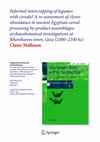
Vegetation History and Archaeobotany, 2016
The possibility that legumes were specifically cultivated as a separate fodder crop in ancient Eg... more The possibility that legumes were specifically cultivated as a separate fodder crop in ancient Egypt has been inferred, usually on the basis of abundance of both legume seeds and / or dung in charred macro-botanical samples, combined with a lack of wood charcoal; the implication being that a scarcity of wood led to the use of dung as fuel, and that the legumes in the assemblage derive from livestock which had been fed with cultivated fodder. The archaeobotanical remains from excavations at the Old Kingdom ‘Khentkawes town’ (2300-2100 BC) on the Giza plateau in Egypt contained an abundance of legumes, but also much wood charcoal, and preservation of many fragile and ‘green’ seeds and plant parts. This assemblage has led to questioning of the theory of specific fodder cultivation in Pharaonic Egypt. In this article, alternative interpretations of legume-rich assemblages of cereal processing by-products are investigated. Intercropping of legumes with cereals is one of the most widespread and effective methods of improving crop value and security, and fodder/forage quality. Analysis of this assemblage has led to a hypothesis that Trifolium sp. and other ‘weeds’ may well have been viewed as integral plants within ancient Egyptian cereal fields, due to an awareness of the benefits of intercropping legumes with cereals - as opposed to having been specifically cultivated as a monocrop.
Ägypten und Levante, 2013
The fifth season of archaeological fieldwork by a Polish-Slovak team at Tell el-Retaba in Wadi Tu... more The fifth season of archaeological fieldwork by a Polish-Slovak team at Tell el-Retaba in Wadi Tumilat uncovered a section of a Hyksos cemetery, fragments of an early Eighteenth Dynasty settlement and a large building belonging to the fortress of Ramesses III, of which only the defense walls have been traced. New data contributed information on the inner structure of the fortress. Continued excavations also unearthed more fragments of a Third Intermediate Period settlement.
• PEAKIT Punches Up 3D Laser Scanning, Adds Accurate Surface Relief
• AERA Honored at the Shan... more • PEAKIT Punches Up 3D Laser Scanning, Adds Accurate Surface Relief
• AERA Honored at the Shanghai Archaeology Forum: Lost City of the Pyramids Named 1 of 10 Major Discoveries in the World
• Returning to the Field: Plans and Preparations for 2014 Excavations
• Silo Building Complex (SBC) 2014: Areas to Dig, Stories to Tell
• Piecing the Story Together, One Clay Sealing Fragment at a Time
• An Ancient Egyptian Insect Repellent
• A Small Clay Label, a Bundle of Linen, and an Ancient Economic Network
• Securing AERA’s Legacy: The Data Curation Project
• AUC-AERA Archaeological Field Training: Launching in January 2015
• AERA Struts Its Stuff at Archaeology Fair
• George Link Memorial Fountain Completed
Tell el-Retaba is one of the more important sites in north-eastern Egypt, located in the middle o... more Tell el-Retaba is one of the more important sites in north-eastern Egypt, located in the middle of Wadi Tumilat, approximately 35 km west of the modern city of Ismailiya. In 2007 a Polish-Slovak Archaeological Mission (PCMA) started explorations with a survey, continued in 2008, which also included geophysical prospection. In 2008, some archaeological testing was carried out. Full scale excavations were planned for 2009, but turned into a rescue attempt once the team had been informed of plans to build a second lane of the asphalt road crossing the western part of the site.
• The Lost Port City of the Pyramids
• How the Pyramid Builders May Have Found Their True North
... more • The Lost Port City of the Pyramids
• How the Pyramid Builders May Have Found Their True North
• First Photos from the Great Pyramid Summit
• Weeds and Seeds: On the Trail of Ancient Egyptian Agriculture
• Egypt's Earliest Olive Pit Reconsidered: A Case of Mistaken Identity?
Sais I. The Ramesside-Third Intermediate Period at Kom Rebwa, 2011
Egypt and the Levant XXI, 2011
Edited Volumes by Claire Malleson
Rawi- Egypt's Heritage Review, 2019
Rawi's 10th edition on the culinary history of Egypt.
Rawi: Egypt's Heritage Review: Egypt's Culinary History, 2019
Realities of Life (Elephantine) by Claire Malleson

In the 2017-2018 season the German Archaeological Institute Cairo and the Swiss Institute for Arc... more In the 2017-2018 season the German Archaeological Institute Cairo and the Swiss Institute for Architectural and Archaeological Research in Cairo continued their field research on Elephantine Island. The work covered settlement investigations of the late Middle and New Kingdom as well as studies on the Late Period Khnum temple precinct. Field research on the decoration of the Greco-Roman temples of Elephantine and the anastylosis of the temple of Osiris-Nesmeti was also continued. To present the long-term work of our Egyptian colleague M. Abd el-Latif on Arabic ostraca, the German Institute prepared a special exhibition in the Annex-Museum on the island, which will be accessible to the public between April and October 2018. Lastly during the past season, the DAIK provided four successful field-training courses, several discussion tours of the site and a study day for Egyptian colleagues.
Handed in to the Ministry of Antiquities in Egypt for publication in ASAE.
في موسم 2017-2018 واصل المعهد الألماني للآثار بالقاهرة والمعهد السويسري للأبحاث المعمارية والأثري... more في موسم 2017-2018 واصل المعهد الألماني للآثار بالقاهرة والمعهد السويسري للأبحاث المعمارية والأثرية في القاهرة أبحاثهما الميدانية في جزيرة إلفنتين. فغطى العمل أبحاث عن المستوطنات في أواخر الدولة الوسطى والحديثة وكذلك دراسات حول منطقة معبد خنوم في العصر المتأخر. كما استمر البحث الميداني في زخرفة معابد إلفنتين اليونانية الرومانية وإعادة بناء معبد أوزيريس-نيسمتي. كما أعد المعهد الألماني معرضًا خاصًا في المتحف الملحق (annex museum) في الجزيرة، لعرض العمل الطويل المدى لزميلنا المصري الدكتور محمد عبد اللطيف على الاوستراكا العربية، والذي تم عرضة للجمهور في الفترة ما بين أبريل وأكتوبر 2018. وأخيرًا خلال الموسم الماضي، قدم المعهد الألماني أربع دورات تدريبية ميدانية ناجحة، وعدة جولات للمناقشة في الموقع، ويوم دراسي للزملاء المصريين.
Handed in to the Ministry of Antiquities in Egypt for publication in ASAE.
في عام 2019، احتفل المعهد الألماني للآثار بالقاهرة (المعهد الألماني) والمعهد السويسري للبحوث المع... more في عام 2019، احتفل المعهد الألماني للآثار بالقاهرة (المعهد الألماني) والمعهد السويسري للبحوث المعمارية والأثرية في القاهرة (المعهد السويسري) بالذكرى السنوية الخمسين للعمل في جزيرة إلفنتين. بعيدًا عن هذا، واصل كلا المعهدين أبحاثهما في موسم 2018-2019. حيث انتهى المعهد الألماني من أعمال التنقيب في طبقات مستوطنة الدولة الوسطى المتأخرة في الجزء الشمالي الغربي من المدينة القديمة، كذلك أجرى سلسلة من الدراسات على المواد التي تم العثور عليها في الموقع وكذلك في المختبرات. كما ركز ايضًا المعهد السويسري على دراسة المواد، من بينها انطباعات الأختام من العصر المتأخر والفخار. بصرف النظر عن ذلك، أجرى أيضًا دراسة الأختام الأسطوانية وانطباعات الأختام التي تم التنقيب عنها من قِبل المعهد الألماني في المواسم الماضية. أخيرًا وليس آخرًا تعاون المعهد الألماني مع وزارة الآثار في تجديد متحف أسوان في جزيرة إلفنتين.
Handed in to the Ministry of Antiquities in Egypt for publication in ASAE.
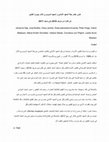
تم القيام بدراسة مدينة إلفنتين الأثرية و معابدها من قبل المعهد الألماني بالقاهرة بالتعاون مع بعثة... more تم القيام بدراسة مدينة إلفنتين الأثرية و معابدها من قبل المعهد الألماني بالقاهرة بالتعاون مع بعثة المعهد السويسري للآثار منذ عام 1969. بدأ موسم 2016 يوم 17 أكتوبر، و انتهي يوم 8 يونيه 2017.
استكمل المعهد الألماني بالقاهرة مشروعه "حقائق الحياة" الذي يجمع ما بين التقنيات العلمية لتحليل البيانات الاثرية في المدينة الشمالية الغربية في إلفنتين الأثرية (القسم 2). تم تنفيذ أعمال الحفائر في الفترة بين خريف 2016 و صيف 2017 و تم تكريس موسمين كاملين لدراسة المُكتشفات. بينما استكمل المعهد السويسري اعمال الحفائر في المنزل 55 جنوب مقبرة حقائيب في إطار دراستها للمدينة التي تعود للدولة الحديثة علي الجزيرة. تم تركيز عمل الموسم في معبد خنوم علي عدة جوانب من المعبد الذي يعود للعصر المتأخر، المنطقة المحيطة به و أثاثه الشعائري (القسم 3).
بالإضافة إلي ذلك، استهدفت عدة مشاريع دراسة القطع المُكتشفة المنفردة و مجموعات القطع. و استمر البحث الميداني الخاص بزخرفة المعابد اليونانية-الرومانية في إلفنتين (القسم 4). كما قام المعهد السوبسري بالمزيد من الاعمال من أجل حفظ و إعادة بناء معبد أوزوريس نسمتي (القسم 5). أجري المعهد الألماني مشروع عن سياق القطع المكتشفة و تلك المُكتشفة التي تعود للفترات الأولي من تاريخ إلفنتين من خلال تحليل كيفيات استغلال الأماكن الاستيطانية (القسم 6).
بسعادة غامرة يُمكننا أن نصرح إنه تم إعادة بناء متحف البعثة (المتحف الملحقAnnex museum )، الذي تم بنائه و تجديده من قبل المعهد الألماني للآثار في ربيع 2017، بالإضافة إلي إفتتاح قاعة محاضرات صغيرة في بيت البعثة الألمانية في جزيرة إلفنتين من أجل تدريب زملائنا المحليين (القسم 7).
Handed in to the Ministry of Antiquities in Egypt for publication in ASAE.
Translated by Mariam Adel William.

The investigation of the ancient town and temples of Elephantine has been carried out by the Germ... more The investigation of the ancient town and temples of Elephantine has been carried out by the German Archaeological Institute Cairo (DAI) in cooperation with the Swiss Institute for Egyptian Building Archaeology (Swiss Institute) since 1969. The 2016-17 season began on October 7th, 2016 and finished on June 8th, 2017*.
The DAI continued its archaeometric project ‘Realities of Life’ in the ancient north-western town of Elephantine (section 2). Between autumn 2016 and summer 2017, one season of excavation was conducted and two seasons were dedicated entirely to the study of the finds. The Swiss Institute resumed the excavation of house 55 to the south of the sanctuary of Heqaib in the framework of its study of the New Kingdom town of the island. In the Khnum temple area work concentrated on various aspects of the late temple, its precinct and its furnishings (section 3).
In addition, several projects were aimed at the study of single objects and object groups. Field research on the decoration of the Greco-Roman temples of Elephantine was continued (section 4). The Swiss Institute did further work for the conservation and rebuilding of the temple of Osiris Nesmeti (section 5). The DAI conducted a project on the context of finds and the objects of the early periods of the history of Elephantine through functional settlement analysis (section 6).
With great pleasure, we can furthermore report the re-opening of the excavation museum (the so-called Annex Museum), built and refurbished by the DAI, which took part in spring 2017, as well as the inauguration of a small auditorium in the German excavation house on the island, for training purposes of our local colleagues (section 7).
Handed in to the Ministry of Antiquities in Egypt for publication in ASAE.
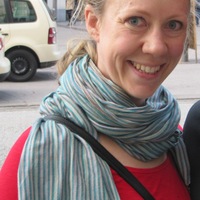





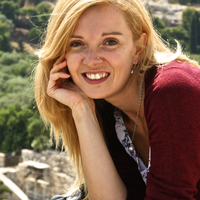
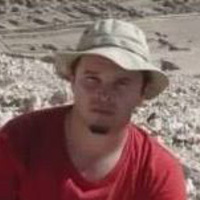



Uploads
Papers by Claire Malleson
This chapter presents a case-study of developing a model for the provisioning of bread to the Old Kingdom 'workers' town of Heit el-Ghurab, Giza, Egypt
• AERA Honored at the Shanghai Archaeology Forum: Lost City of the Pyramids Named 1 of 10 Major Discoveries in the World
• Returning to the Field: Plans and Preparations for 2014 Excavations
• Silo Building Complex (SBC) 2014: Areas to Dig, Stories to Tell
• Piecing the Story Together, One Clay Sealing Fragment at a Time
• An Ancient Egyptian Insect Repellent
• A Small Clay Label, a Bundle of Linen, and an Ancient Economic Network
• Securing AERA’s Legacy: The Data Curation Project
• AUC-AERA Archaeological Field Training: Launching in January 2015
• AERA Struts Its Stuff at Archaeology Fair
• George Link Memorial Fountain Completed
• How the Pyramid Builders May Have Found Their True North
• First Photos from the Great Pyramid Summit
• Weeds and Seeds: On the Trail of Ancient Egyptian Agriculture
• Egypt's Earliest Olive Pit Reconsidered: A Case of Mistaken Identity?
Edited Volumes by Claire Malleson
Realities of Life (Elephantine) by Claire Malleson
Handed in to the Ministry of Antiquities in Egypt for publication in ASAE.
Handed in to the Ministry of Antiquities in Egypt for publication in ASAE.
Handed in to the Ministry of Antiquities in Egypt for publication in ASAE.
استكمل المعهد الألماني بالقاهرة مشروعه "حقائق الحياة" الذي يجمع ما بين التقنيات العلمية لتحليل البيانات الاثرية في المدينة الشمالية الغربية في إلفنتين الأثرية (القسم 2). تم تنفيذ أعمال الحفائر في الفترة بين خريف 2016 و صيف 2017 و تم تكريس موسمين كاملين لدراسة المُكتشفات. بينما استكمل المعهد السويسري اعمال الحفائر في المنزل 55 جنوب مقبرة حقائيب في إطار دراستها للمدينة التي تعود للدولة الحديثة علي الجزيرة. تم تركيز عمل الموسم في معبد خنوم علي عدة جوانب من المعبد الذي يعود للعصر المتأخر، المنطقة المحيطة به و أثاثه الشعائري (القسم 3).
بالإضافة إلي ذلك، استهدفت عدة مشاريع دراسة القطع المُكتشفة المنفردة و مجموعات القطع. و استمر البحث الميداني الخاص بزخرفة المعابد اليونانية-الرومانية في إلفنتين (القسم 4). كما قام المعهد السوبسري بالمزيد من الاعمال من أجل حفظ و إعادة بناء معبد أوزوريس نسمتي (القسم 5). أجري المعهد الألماني مشروع عن سياق القطع المكتشفة و تلك المُكتشفة التي تعود للفترات الأولي من تاريخ إلفنتين من خلال تحليل كيفيات استغلال الأماكن الاستيطانية (القسم 6).
بسعادة غامرة يُمكننا أن نصرح إنه تم إعادة بناء متحف البعثة (المتحف الملحقAnnex museum )، الذي تم بنائه و تجديده من قبل المعهد الألماني للآثار في ربيع 2017، بالإضافة إلي إفتتاح قاعة محاضرات صغيرة في بيت البعثة الألمانية في جزيرة إلفنتين من أجل تدريب زملائنا المحليين (القسم 7).
Handed in to the Ministry of Antiquities in Egypt for publication in ASAE.
Translated by Mariam Adel William.
The DAI continued its archaeometric project ‘Realities of Life’ in the ancient north-western town of Elephantine (section 2). Between autumn 2016 and summer 2017, one season of excavation was conducted and two seasons were dedicated entirely to the study of the finds. The Swiss Institute resumed the excavation of house 55 to the south of the sanctuary of Heqaib in the framework of its study of the New Kingdom town of the island. In the Khnum temple area work concentrated on various aspects of the late temple, its precinct and its furnishings (section 3).
In addition, several projects were aimed at the study of single objects and object groups. Field research on the decoration of the Greco-Roman temples of Elephantine was continued (section 4). The Swiss Institute did further work for the conservation and rebuilding of the temple of Osiris Nesmeti (section 5). The DAI conducted a project on the context of finds and the objects of the early periods of the history of Elephantine through functional settlement analysis (section 6).
With great pleasure, we can furthermore report the re-opening of the excavation museum (the so-called Annex Museum), built and refurbished by the DAI, which took part in spring 2017, as well as the inauguration of a small auditorium in the German excavation house on the island, for training purposes of our local colleagues (section 7).
Handed in to the Ministry of Antiquities in Egypt for publication in ASAE.
This chapter presents a case-study of developing a model for the provisioning of bread to the Old Kingdom 'workers' town of Heit el-Ghurab, Giza, Egypt
• AERA Honored at the Shanghai Archaeology Forum: Lost City of the Pyramids Named 1 of 10 Major Discoveries in the World
• Returning to the Field: Plans and Preparations for 2014 Excavations
• Silo Building Complex (SBC) 2014: Areas to Dig, Stories to Tell
• Piecing the Story Together, One Clay Sealing Fragment at a Time
• An Ancient Egyptian Insect Repellent
• A Small Clay Label, a Bundle of Linen, and an Ancient Economic Network
• Securing AERA’s Legacy: The Data Curation Project
• AUC-AERA Archaeological Field Training: Launching in January 2015
• AERA Struts Its Stuff at Archaeology Fair
• George Link Memorial Fountain Completed
• How the Pyramid Builders May Have Found Their True North
• First Photos from the Great Pyramid Summit
• Weeds and Seeds: On the Trail of Ancient Egyptian Agriculture
• Egypt's Earliest Olive Pit Reconsidered: A Case of Mistaken Identity?
Handed in to the Ministry of Antiquities in Egypt for publication in ASAE.
Handed in to the Ministry of Antiquities in Egypt for publication in ASAE.
Handed in to the Ministry of Antiquities in Egypt for publication in ASAE.
استكمل المعهد الألماني بالقاهرة مشروعه "حقائق الحياة" الذي يجمع ما بين التقنيات العلمية لتحليل البيانات الاثرية في المدينة الشمالية الغربية في إلفنتين الأثرية (القسم 2). تم تنفيذ أعمال الحفائر في الفترة بين خريف 2016 و صيف 2017 و تم تكريس موسمين كاملين لدراسة المُكتشفات. بينما استكمل المعهد السويسري اعمال الحفائر في المنزل 55 جنوب مقبرة حقائيب في إطار دراستها للمدينة التي تعود للدولة الحديثة علي الجزيرة. تم تركيز عمل الموسم في معبد خنوم علي عدة جوانب من المعبد الذي يعود للعصر المتأخر، المنطقة المحيطة به و أثاثه الشعائري (القسم 3).
بالإضافة إلي ذلك، استهدفت عدة مشاريع دراسة القطع المُكتشفة المنفردة و مجموعات القطع. و استمر البحث الميداني الخاص بزخرفة المعابد اليونانية-الرومانية في إلفنتين (القسم 4). كما قام المعهد السوبسري بالمزيد من الاعمال من أجل حفظ و إعادة بناء معبد أوزوريس نسمتي (القسم 5). أجري المعهد الألماني مشروع عن سياق القطع المكتشفة و تلك المُكتشفة التي تعود للفترات الأولي من تاريخ إلفنتين من خلال تحليل كيفيات استغلال الأماكن الاستيطانية (القسم 6).
بسعادة غامرة يُمكننا أن نصرح إنه تم إعادة بناء متحف البعثة (المتحف الملحقAnnex museum )، الذي تم بنائه و تجديده من قبل المعهد الألماني للآثار في ربيع 2017، بالإضافة إلي إفتتاح قاعة محاضرات صغيرة في بيت البعثة الألمانية في جزيرة إلفنتين من أجل تدريب زملائنا المحليين (القسم 7).
Handed in to the Ministry of Antiquities in Egypt for publication in ASAE.
Translated by Mariam Adel William.
The DAI continued its archaeometric project ‘Realities of Life’ in the ancient north-western town of Elephantine (section 2). Between autumn 2016 and summer 2017, one season of excavation was conducted and two seasons were dedicated entirely to the study of the finds. The Swiss Institute resumed the excavation of house 55 to the south of the sanctuary of Heqaib in the framework of its study of the New Kingdom town of the island. In the Khnum temple area work concentrated on various aspects of the late temple, its precinct and its furnishings (section 3).
In addition, several projects were aimed at the study of single objects and object groups. Field research on the decoration of the Greco-Roman temples of Elephantine was continued (section 4). The Swiss Institute did further work for the conservation and rebuilding of the temple of Osiris Nesmeti (section 5). The DAI conducted a project on the context of finds and the objects of the early periods of the history of Elephantine through functional settlement analysis (section 6).
With great pleasure, we can furthermore report the re-opening of the excavation museum (the so-called Annex Museum), built and refurbished by the DAI, which took part in spring 2017, as well as the inauguration of a small auditorium in the German excavation house on the island, for training purposes of our local colleagues (section 7).
Handed in to the Ministry of Antiquities in Egypt for publication in ASAE.
Handed in to the Ministry of Antiquities in Egypt for publication in ASAE.
Please see the attached program and abstracts for a full description of the event and speakers.